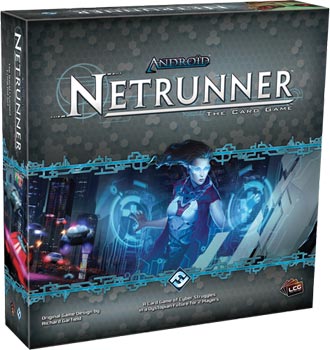 Rumors of my death have been greatly exaggerated. For those of you who don’t remember me (basically everyone), I used to be a Magic writer here. For reasons I’m sure no one cares about, I’ve stopped playing Magic. However, as the saying goes, once a gamer, always a gamer, so I’ve been looking for something else to fill the void. I’ve always heard great things about Android: Netrunner, so I gave it a try this summer, and boy am I hooked. It’s a fantastically deep game, and I’ve had a blast playing it thus far. I suspect there are a lot of Magic players out there who would also love Netrunner given the chance to try it out, so this article is for you.
Rumors of my death have been greatly exaggerated. For those of you who don’t remember me (basically everyone), I used to be a Magic writer here. For reasons I’m sure no one cares about, I’ve stopped playing Magic. However, as the saying goes, once a gamer, always a gamer, so I’ve been looking for something else to fill the void. I’ve always heard great things about Android: Netrunner, so I gave it a try this summer, and boy am I hooked. It’s a fantastically deep game, and I’ve had a blast playing it thus far. I suspect there are a lot of Magic players out there who would also love Netrunner given the chance to try it out, so this article is for you.
Netrunner is similar to Magic in many ways, but it’s very different in many others. The biggest difference is the distribution model. Unlike Magic’s randomized booster packs, Netrunner is released under Fantasy Flight Games’s Living Card Game system. That means you always know what you’re receiving when you buy any Netrunner product. You start out by picking up a Core Set, which has everything you need to play. New sets, called Data Packs, come out roughly monthly. They’re about the size of the old Magic tournament packs (or starter decks for you old timers), cost about $10–$15 and give you play sets of every card. There are also larger Deluxe Expansions that come out about once a year. You can easily have a rewarding experience with just a Core Set though.
Like Magic, Netrunner is a game in which both players come to the table with a deck they customized for themselves (or found a decklist for on the Internet). The key difference is that Netrunner is an asymmetrical game. One player takes the role of the Corporation, and the other plays as the Runner. Every card in the game is either a Corporation card or a Runner card—you can’t play Runner cards in a Corporation deck or vice versa. Within both sides are several different factions, four for the Corporation and three for the Runner. These factions are like the different colors of Magic, each with their own strengths and weaknesses. You can splash a certain number of off-faction cards, which gives you a ton of flexibility in building your deck even within a small card pool.
Another similarity Netrunner has to Magic is that they’re both games of resource management. In Magic, your main resources are cards and mana. The constraint you face in most situations is that you draw one card and play one land per turn. If one player is able to pull ahead in either of those resources, he or she will have an easier time winning. In Netrunner, your main resources are actions (clicks) and money (credits). You’re instead constrained by the number of actions you can take on your turn. Among many other things, you can spend an action to play a card from your hand, draw a card from your deck, or receive one credit from the bank. Both players have four actions, although the Corporation’s first action is always a mandatory draw. Getting the most out of your actions, what Netrunner players call “click compression,” is how you pull ahead. Credits function like the mana of the game, allowing you to play cards or pay for activated abilities.
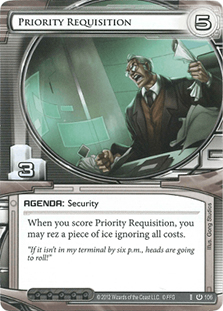 The object of the game is to score 7 agenda points. The Corporation deck will have a certain number of agenda cards like this one. The number on the left is how many points it’s worth. The number on the top right is the cost to score it. For the Corporation to score an agenda, the player must use an action to play the card face down and then spend one credit and one action for each advancement counter. Once there are at least as many counters on it as the cost (the top-right number), the Corporation scores that agenda. That means Priority Requisition takes two full turns to score (one action to play it and five more to advance it five times). So how does the Runner score? That brings us to the heart of the game: runs. The Runner can spend one of her actions to make a run at the Corporation’s hand, deck, or discard pile or any of the Corporation player’s face-down cards. If successful, this is what happens depending on where the Runner chose to attack:
The object of the game is to score 7 agenda points. The Corporation deck will have a certain number of agenda cards like this one. The number on the left is how many points it’s worth. The number on the top right is the cost to score it. For the Corporation to score an agenda, the player must use an action to play the card face down and then spend one credit and one action for each advancement counter. Once there are at least as many counters on it as the cost (the top-right number), the Corporation scores that agenda. That means Priority Requisition takes two full turns to score (one action to play it and five more to advance it five times). So how does the Runner score? That brings us to the heart of the game: runs. The Runner can spend one of her actions to make a run at the Corporation’s hand, deck, or discard pile or any of the Corporation player’s face-down cards. If successful, this is what happens depending on where the Runner chose to attack:
- Hand: Look at a random card in the Corporation’s hand.
- Deck: Look at the top card of the Corporation’s deck.
- Discard pile: Look at the entire discard pile (discarding from hand or milling is face down).
- Face-down cards: Look at them.
Looking at cards in this way is called accessing. Whenever the runner accesses an agenda, she steals it and immediately scores those points. Runs are like attacks in Magic except you have choices of where to attack. And just like Magic, you can block. The Corporation can play cards called ice to protect themselves. Wall of Static is a simple one. The Corporation plays ice face down protecting her hand, deck, discard pile, or one of her face-down cards. The number in the top left is the cost (in credits) to turn the ice face up. This called rezzing. The number in the bottom left is its strength, which I’ll get to later. If the Runner can’t deal with the ice, you resolve what the card says in order. Each little arrow is called a subroutine. Wall of Static only has one, but others can have many. Rezzing ice is a one-time cost. Once you pay it, the ice stays face up, and the Runner will have to deal with it each time he makes a run at that location. Ice can have all sorts of different effects, ranging from simple end-the-run subroutines to some downright nasty ones that can trash the Runner’s cards or worse.
So how does the Runner deal with ice, you might ask? That would be with cards called icebreakers. Corroder is a good example. The number at the top left is how much it costs (in credits) to play the card. The number at the bottom left is its strength. Corroder has two activated abilities, which work exactly the same way as they do in Magic. That goofy-looking hexagon is the credit symbol, so it costs 1 credit to pump Corroder’s strength by 1 and 1 credit to break a barrier subroutine. Let’s look at that Wall of Static again. It says “Barrier,” so we know we have the right tool for the job. Here’s where the strengths of the ice and the icebreaker come in. The icebreaker has to have strength at least as high as the ice in order to interact with it. Corroder has a base strength of 2, so it costs us 2 credits to break through Wall of Static—1 to pump the strength and 1 to break the subroutine. If the Runner decides to keep going, she’ll have to deal with any additional ice if there are any. After each piece of ice, the Runner chooses if she wants to keep going or stop. The Runner doesn’t usually know what cards the Corporation might be hiding and has to guess at what they could be.
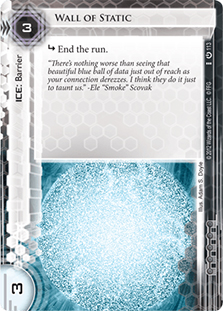 To me, this is what makes Netrunner so interesting. Both players are in this game of cat and mouse, always trying to figure out what his or her opponent might be doing. I find it to be much more interactive than Magic. Magic often suffers from solitaire-feeling games in which one player doesn’t care what his opponent is doing either because it doesn’t matter or because he can’t do anything anyway. That doesn’t really happen in Netrunner. You always have to pay attention to what your opponent is doing, and you almost always have highly relevant decisions to make. Should you spend your turn drawing cards or gaining credits? How safe are you to make a run that has unknown ice without a full suite of icebreakers? Is it safe to try to score your agenda now? Is that face-down card an agenda or a trap? This is what Netrunner is all about. The game also doesn’t suffer from problems such as mana screw. If you don’t have a particular card you need, just keep spending your actions to draw extra cards until you find it. If you don’t have enough money, just spend your turn gaining credits. Because your resources (actions and money) aren’t tied to actual cards, you almost never just sit there doing nothing while watching your opponent thrash you mercilessly.
To me, this is what makes Netrunner so interesting. Both players are in this game of cat and mouse, always trying to figure out what his or her opponent might be doing. I find it to be much more interactive than Magic. Magic often suffers from solitaire-feeling games in which one player doesn’t care what his opponent is doing either because it doesn’t matter or because he can’t do anything anyway. That doesn’t really happen in Netrunner. You always have to pay attention to what your opponent is doing, and you almost always have highly relevant decisions to make. Should you spend your turn drawing cards or gaining credits? How safe are you to make a run that has unknown ice without a full suite of icebreakers? Is it safe to try to score your agenda now? Is that face-down card an agenda or a trap? This is what Netrunner is all about. The game also doesn’t suffer from problems such as mana screw. If you don’t have a particular card you need, just keep spending your actions to draw extra cards until you find it. If you don’t have enough money, just spend your turn gaining credits. Because your resources (actions and money) aren’t tied to actual cards, you almost never just sit there doing nothing while watching your opponent thrash you mercilessly.
I won’t go into the full details of how to play, but that’s the general gist of it. Here are some resources if you want to learn more:
- Full rules
- Card-search websites: www.onosendaicorp.com, www.netrunnerdb.com
- Strategy articles and tournament decklists
I imagine that if you’re still reading this, you’ll probably have a bunch of questions. Here are some of the questions (and answers, too, I guess) I had when I first started playing:
How Expensive Is It to Get into This Game?
That really depends on you. A single Core Set has everything you need to make decks that function, and if you only plan on playing with one or two of your friends, that’s all you really need. The Core Set is actually chock-full of powerful cards that remain tournament staples to this day. Buying expansions will definitely make your decks better, but doing so is by no means necessary. When I first started playing, I had only a Core Set and played against people with “real” decks. Yes, I lost more than I won, but I still won occasionally. It’s nothing like taking a Standard Event Deck to a Legacy tournament.
That said, there are a couple Data Packs I’d recommend grabbing early on. The Corporation decks out of the box are quite weak, and expanding your card pool a little goes a long way. Good ones to start out with are Cyber Exodus, Future Proof, and What Lies Ahead. If you decide you like the game, I definitely recommend picking up a second Core Set at some point. For some reason, the Core Set doesn’t have play sets of every card, and some of the one-ofs are cards you want more than one of. Also, it makes having multiple decks a lot more convenient.
Even if you go balls-out purchasing three Core Sets and every single expansion, you’re still only looking at a few hundred dollars at most—about the cost of your typical Standard deck.
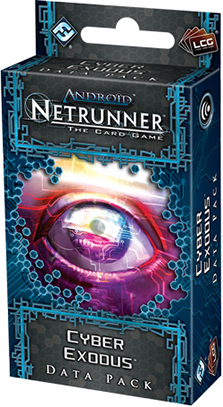 | 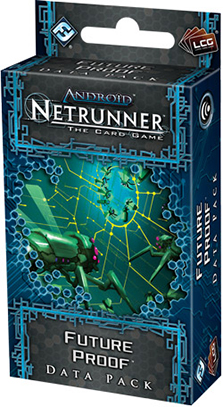 |  |
Is There an Organized Play Program?
Netrunner does have an organized play program, but as the scene is much smaller than Magic’s, there’s nothing resembling the Pro Tour. Many stores will have the equivalent of Friday Night Magic. Larger tournaments include Store Championships, Regionals, Nationals, and Worlds. For the most part, these tournaments don’t have cash prizes. Instead, the prizes are things like promo cards or play mats.
How Do Tournaments Work Exactly?
Full disclosure: I haven’t actually played a Netrunner tournament before, so this is just what I’ve been told by tournament players.
Each player has both a Corporation deck and a Runner deck. You play two games against your opponent, one with each deck. You earn 2 points for each game win (I think draws award 1 point to each player, but don’t quote me on that one). The tournament is run Swiss-style, just like Magic tournaments. Larger tournaments will have a cut to Top 8 or Top 16 and then proceed to double elimination. For the elimination rounds, you play a single game, alternating between Corporation and Runner each round.
How Hard Is It to Find People to Play With?
That depends on where you live. If you live in a large, urban area, you shouldn’t have any difficulty. It seems that every little town with a stop sign has a Magic shop that runs FNM these days, but Netrunner is nowhere near that big. One of the few things I do find frustrating about Netrunner is that there’s no centralized event locator like Magic has. You’ll just have to call up each store in your area to see if it runs Netrunner events.
Fortunately, you can play online with a client called OCTGN. I haven’t tried it out, but it’s quite popular with the Netrunner players I’ve talked to.
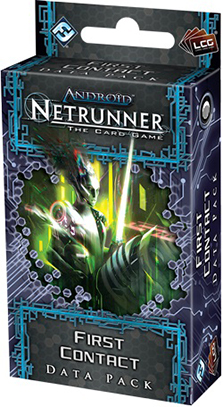
I hope I’ve piqued your curiosity enough for you to try out Netrunner. If you have any questions, feel free to drop me a line in the comments.
Cheers,
Nassim Ketita























